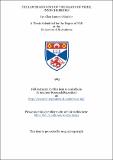Files in this item
The Lewisian rocks of the Island of Tiree, Inner Hebrides
Item metadata
| dc.contributor.advisor | Davidson, C. F. | |
| dc.contributor.author | Sinclair, Iain Glen Lamond | |
| dc.coverage.spatial | 253 p. | en_US |
| dc.date.accessioned | 2018-07-18T14:49:07Z | |
| dc.date.available | 2018-07-18T14:49:07Z | |
| dc.date.issued | 1963 | |
| dc.identifier.uri | https://hdl.handle.net/10023/15544 | |
| dc.description.abstract | The research work presented in this thesis was undertaken to determine the nature and the relationships of the rocks which make up the Lewisian Complex on the Island of Tiree, and to attempt to interpret their metamorphic history. The rocks have been mapped and some 250 thin-sections examined in the laboratory, Twenty-one chemical analyses have been executed using rapid techniques. The complex has been found to consist predominantly of migmatites but there also occur some bodies of fairly homogeneous intermediate, basic and ultrabasic gneiss. The general outlines of these bodies are generally more or less conformable with the trend of the banding in the enclosing migmatite. The commonest type of migmatite is a light to medium grey, generally well banded rook, the principal mafia components of which are hornblende and biotite. It is designated the Banded Migmatite. Two other varieties, the Massive Migmatite and the Contorted Migmatite, occur in lesser amount, The Massive Migmatite contains varying amounts of clinopyroxene and ortho-pyroxene in addition to some hornblende and minor biotite; banding within it is generally weakly developed and sometimes completely absent. The Contorted Migatite has a streaky rather than banded appearance and irregular contortions and crenulations s are common within it. The principal mafic component of this phase of the migmatite is biotite and, at one locality, it also contains varying amounts of orthopyroxone and garnet. The mineral assemblage in the Banded Migmatite is indicative of crystallization in the upper amphibolites facies end that in the Massive Migmatite suggests lower granulate facies. The presence of both orthopyroxene and biotite in the Contorted Migmatite indicates that the assemblage in that phase is one transitional between the amphibolite and the granulite facies and that equilibrium was probably not attained within it during metamorphism. Throughout the migmatite mass there occur 'resister' (Road, 1957) bands and lenses of basic, ultrabasic and met sedimentary rock. These bodies of 'resister' rook are in almost all cases extended parallel to the banding of the enclosing sigcatite. Concordant and transgressive veins and hands of acid pegmatite are common and 'resister' bands are often penetrated and disrupted by pegmatitie materiel. The 'resister' bands appear, therefore, to have been in a much more brittle condition during migmatitization than was the enclosing rock. The mineral assemblages within the broader 'resister' bands are often suggestive of crystallization under lower granulite facies conditions but in the narrower bands and lenses and in the marginal, zones of the broad hands, amphibolite facies assemblages occur; chemical analyses suggest that the mineralogical transformations in the 'resister' bands were essentially isochemical. A series of analyses between the centre and the margin of a large ultrabasic lens reveal that its marginal zone is richer n silica, lime, cinema and awnina and alkalies poorer in magnesia and iron oxides, compared with its interior. The contamination of the marginal, zone is considered to have taken place during the migmatitization of the enclosing rocks when fluids worn available to facilitate diffusion. Isoclinal folds with axial planes parallel to the banding of the migmatite occur in occasional, basic lenses, Their presence demonstrates that the palacosome had been folded prior to migmatitization and that the same stress system probably prevailed during both these processes, Textural evidence, although not conclusive, suggests that in the broad btzsia 'resistor' bands the pyroxene has, at least in part, formed at the expense of pre-existent hornblende, Furthermore, there is no textural evidence, such as the rimuning of pyroxene grains by amphibole, to suggest that the amphibole assemblages in the marginal zones of these bends have formed by diaphthoresis of a granulite facies assemblage. | en_US |
| dc.language.iso | en | en_US |
| dc.publisher | University of St Andrews | |
| dc.subject.lcc | QE262.T5S5 | |
| dc.subject.lcsh | Geology | en |
| dc.title | The Lewisian rocks of the Island of Tiree, Inner Hebrides | en_US |
| dc.type | Thesis | en_US |
| dc.contributor.sponsor | Department of Scientific and Industrial Research (DSIR) | en_US |
| dc.type.qualificationlevel | Doctoral | en_US |
| dc.type.qualificationname | PhD Doctor of Philosophy | en_US |
| dc.publisher.institution | The University of St Andrews | en_US |
This item appears in the following Collection(s)
Items in the St Andrews Research Repository are protected by copyright, with all rights reserved, unless otherwise indicated.

